#isabella clara eugenia
Explore tagged Tumblr posts
Text

Portrait of the Infanta Isabella
Artist: Peter Paul Rubens (Flemish, 1577–1640)
Title: Portrait of Isabella Clara Eugenia regent of the Netherlands
Genre: Portrait
Date: circa 1615
Medium: Oil on Canvas
Collection: National Gallery, Westminster, England
Isabella Clara Eugenia (Spanish: Isabel Clara Eugenia; 12 August 1566 – 1 December 1633), sometimes referred to as Clara Isabella Eugenia, was sovereign of the Spanish Netherlands, which comprised the Low Countries and the north of modern France with her husband, Archduke Albert VII of Austria.
Their reign is considered the Golden Age of the Spanish Netherlands, which saw a revival of its economy and arts after a peace was concluded with the break-away Dutch Republic. Isabella was one of the most powerful women in 16th- and 17th-century Europe.
#portrait#17th century painting#infanta isabella#oil on canvas painting#isabella clara eugenia#spanish netherlands#17th century europe#peter paul rubens#flemish painter#spanish#spanish nobility
22 notes
·
View notes
Text
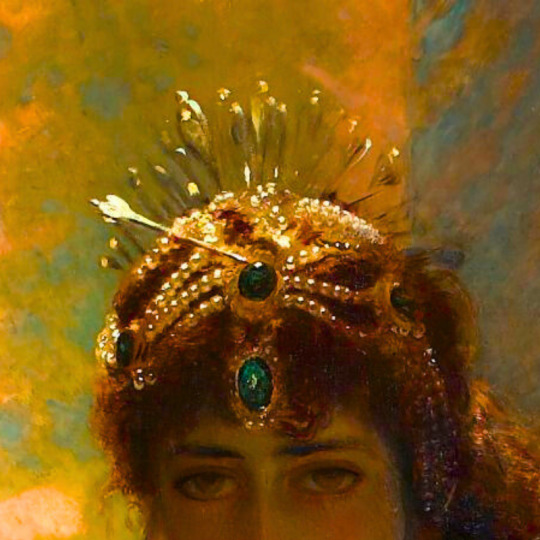
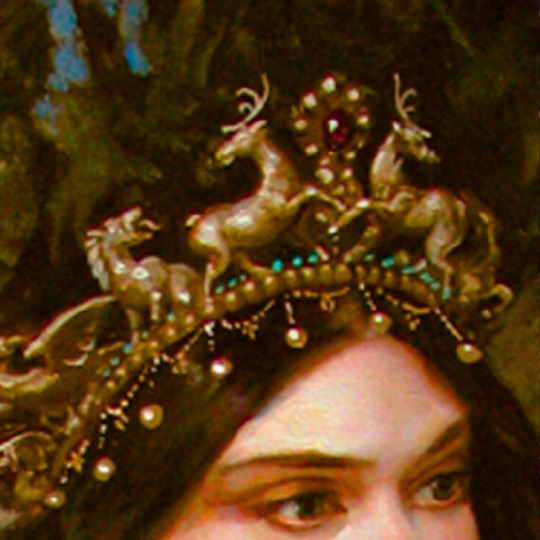
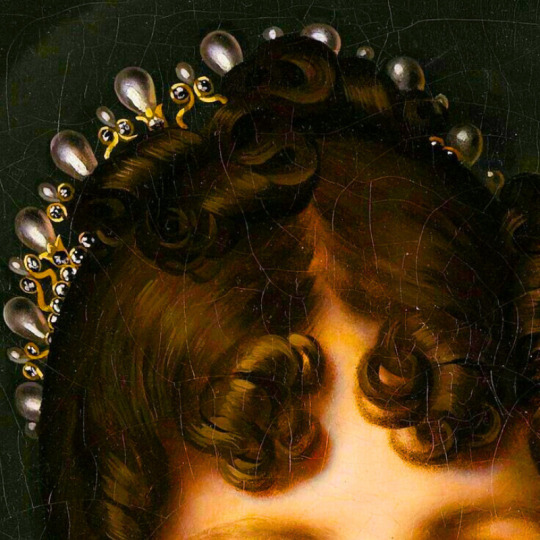
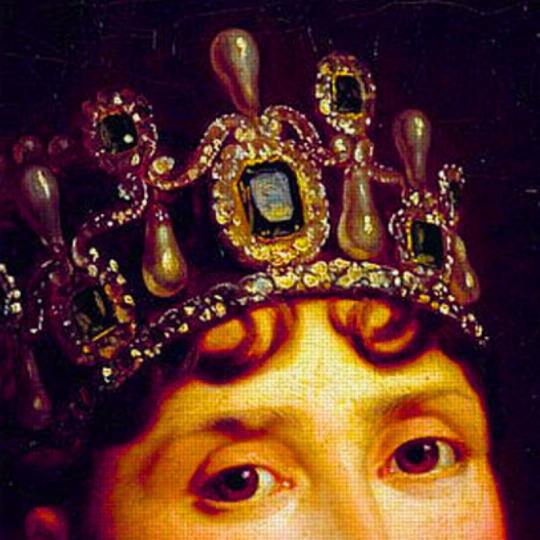
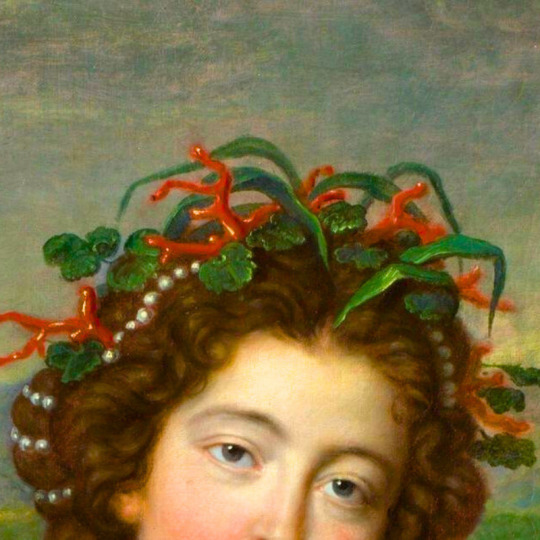
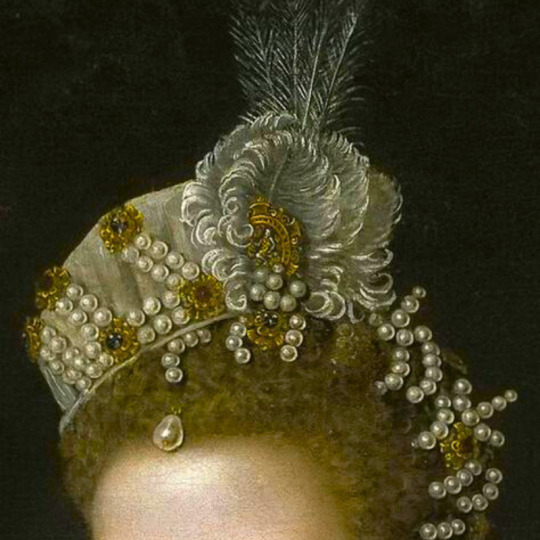
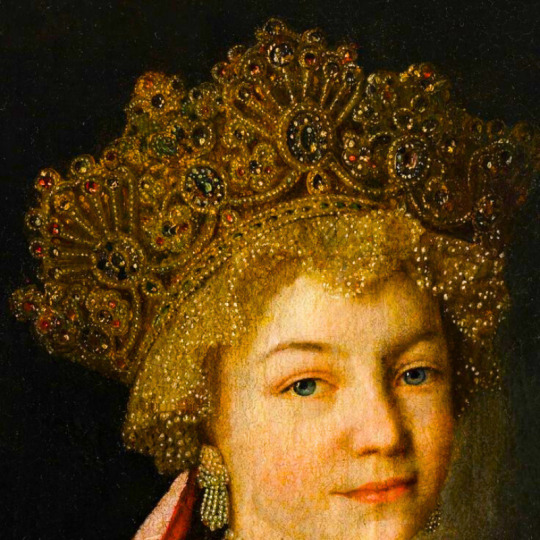
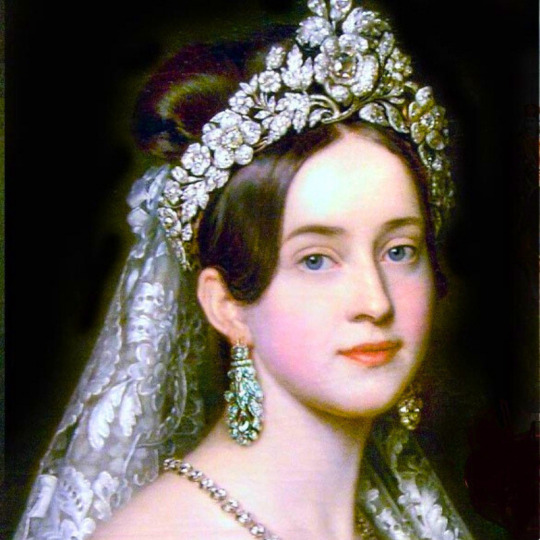
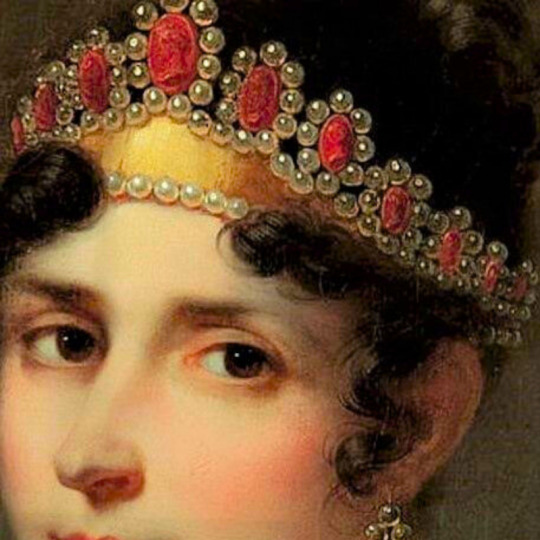
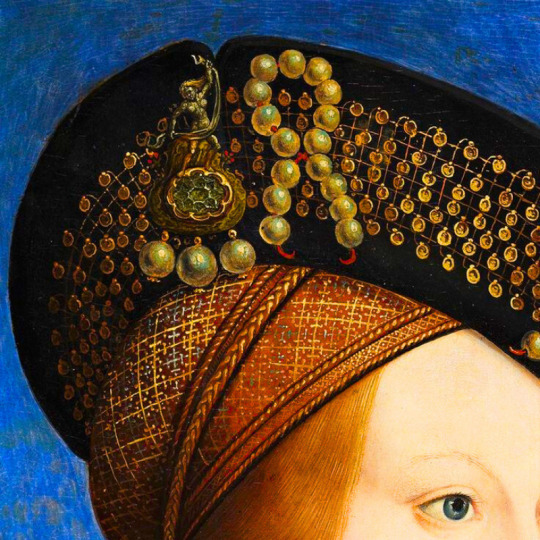
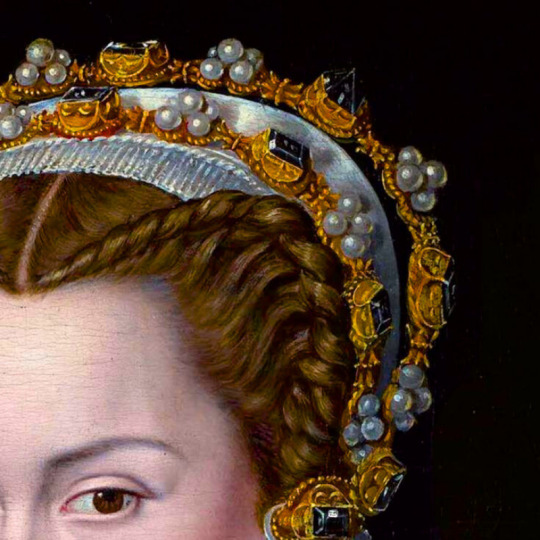
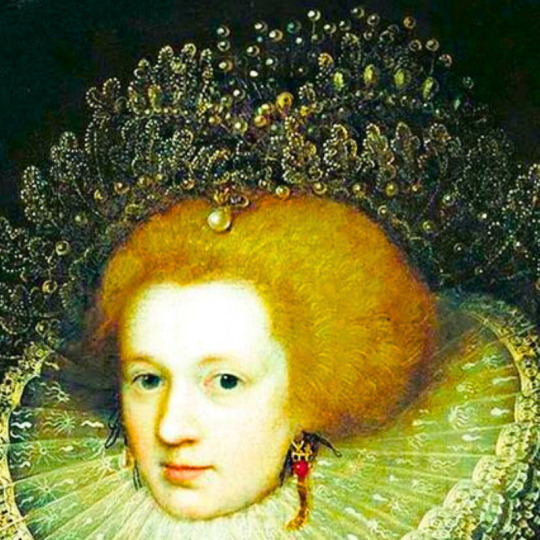

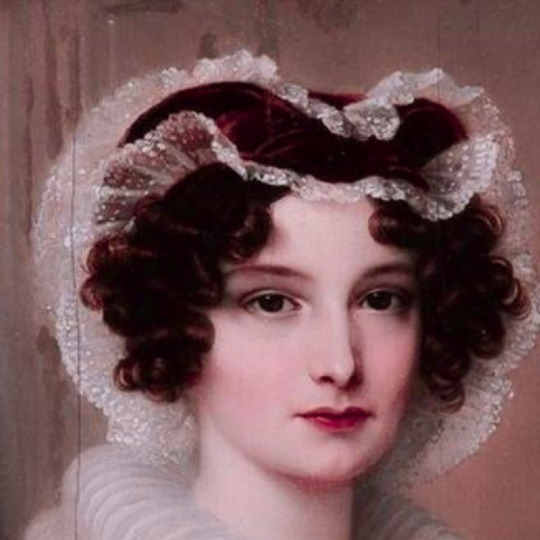
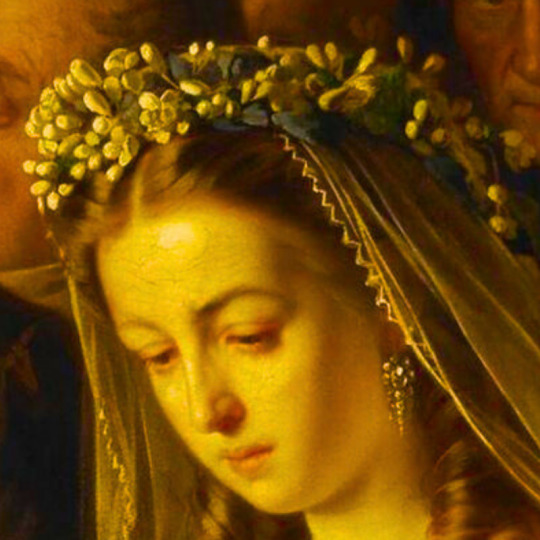
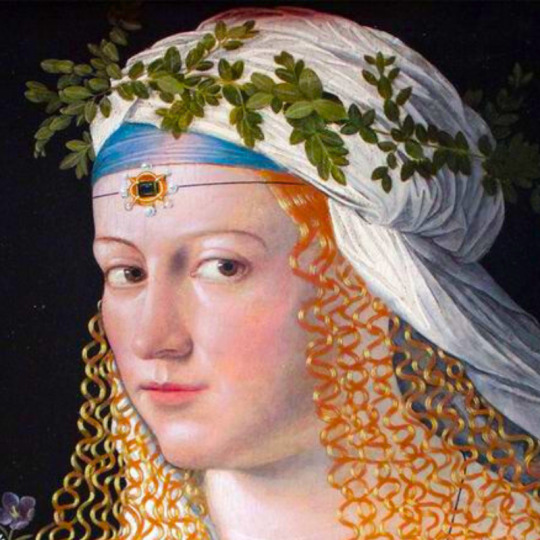
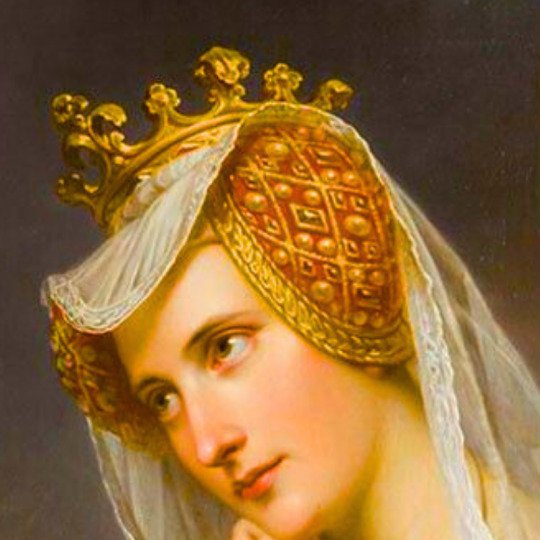
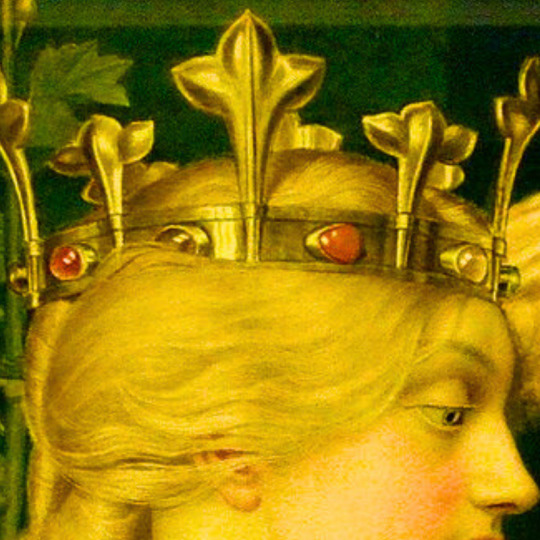
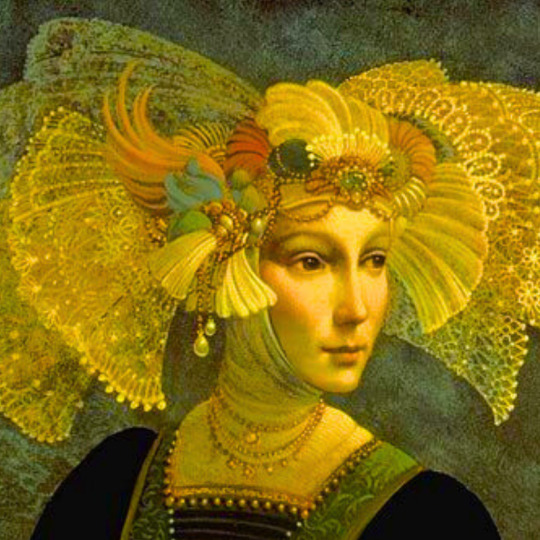
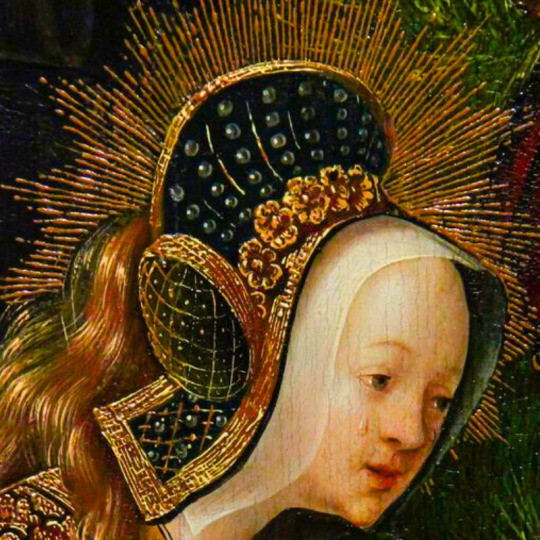

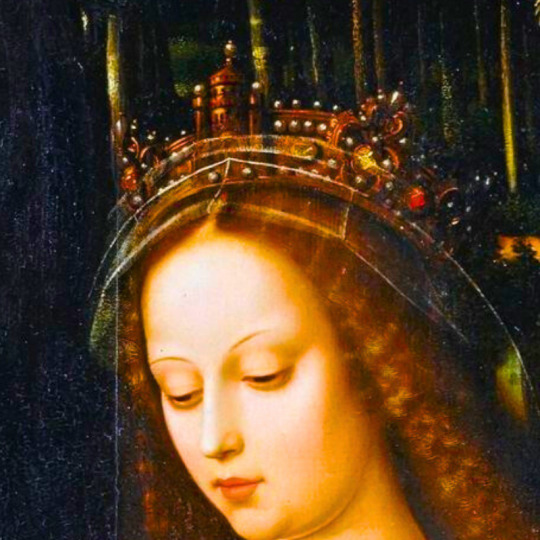
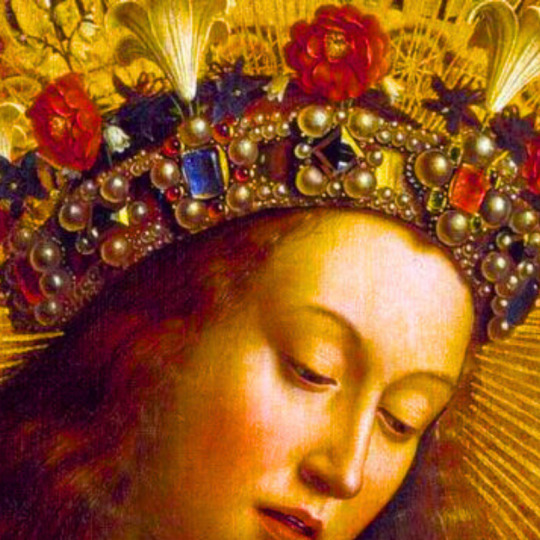
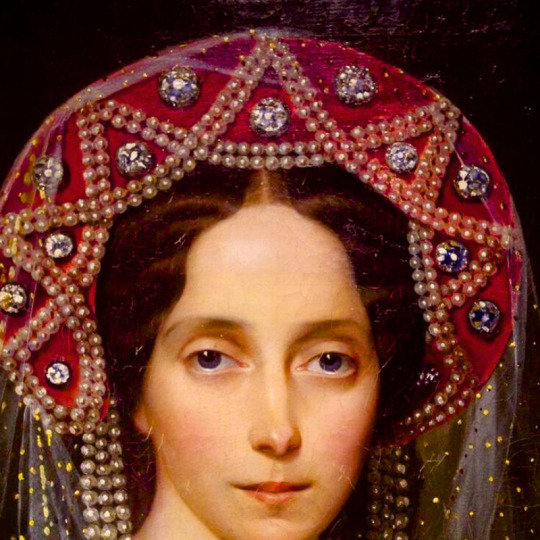


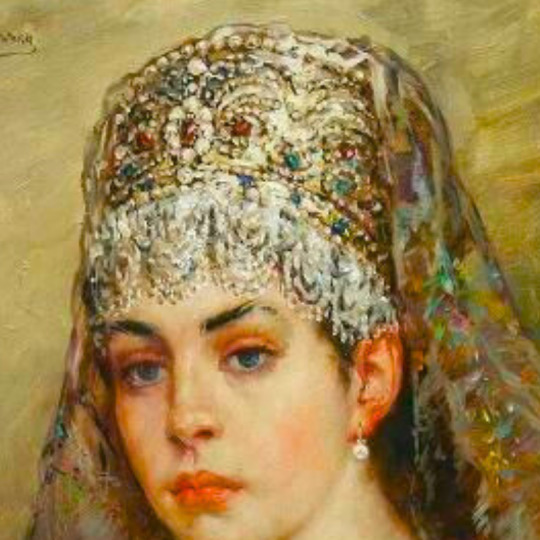
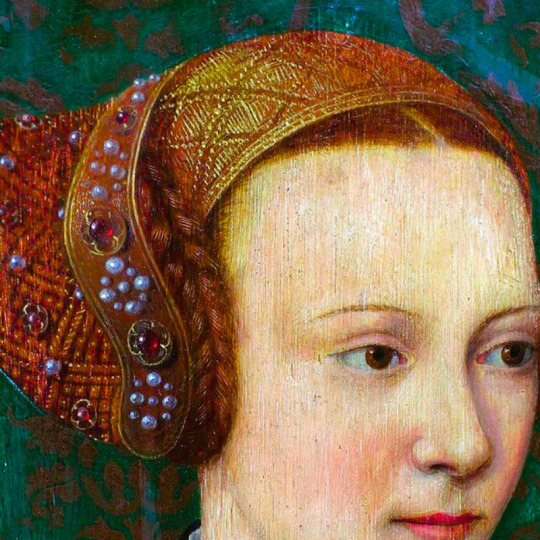
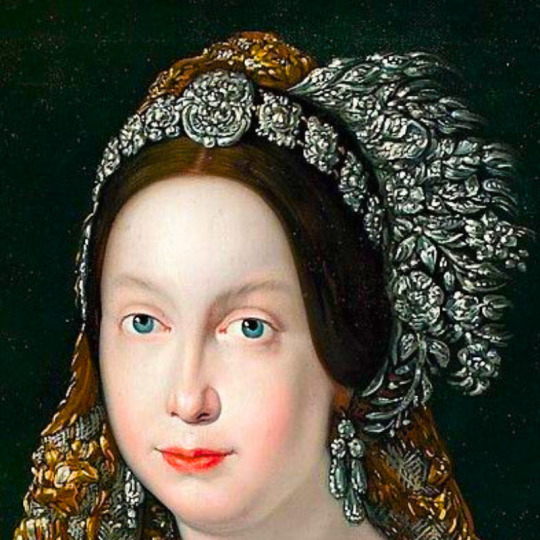
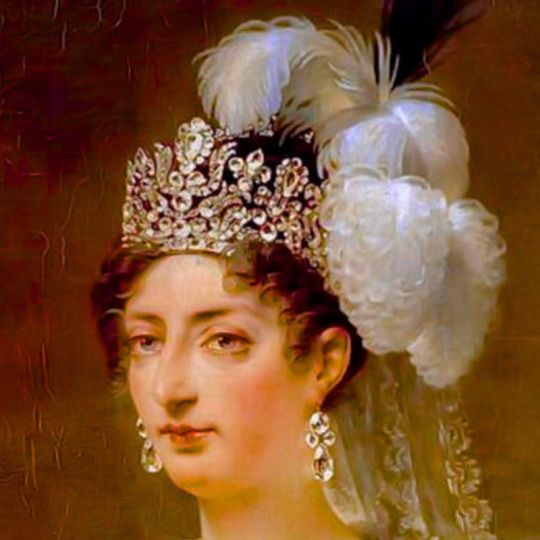
art + hair pieces
#orientatalin by edouard frederic wilhelm richter#cant find this one#this one either its tougher than you think to reverse search them#portrait of josephine de beauharnais by francois gerard#the marquise de seignelay and two of her sons by pierre mignard#infantin isabella clara eugenia at age 13 by alonso sanchez coello#grand duchess alexandra pavlovna romanova of russia but i cant find the artist#marie frederike amalie queen of greece by joseph karl stieler#empress josephine by jean louis viger#queen anna of hungary and bohemia by hans maler#elisabeth of austria by jooris van der straaten#anne wortley by paul van somer#manuela gonzalez velazquez tocando el piano by zacarias gonzalez velazquez#adelingen by heinrich friederich fuger#the unequal marriage by vasili pukirev#idealised portrait of a young women as flora by bartolomeo veneto#a portrait of a noble lady by jan adam kruseman#changing the letter by joseph edward southall#lorelei by james c christensen#the crucifixion by jacob cornelisz van oostsanen#saint dorothy i think this is the title its kinda confusing by i cant find the artist#saint barbara by ambrosius benson#virgin mary by hubert van eyck and jan van eyck#princess maria alexandrovna by ivan makarov#ladies in the blazon room of the winter palace by adolphe ladurner#queen marie therese and her son by charles beaubrun#boyar's wife by konstantin yegorovich#dont know the title but its by barthel bruyn the elder#queen isabella ii of spain by unknown artist#portrait of maria therese charlotte of france by antoine-jean gros
1K notes
·
View notes
Photo
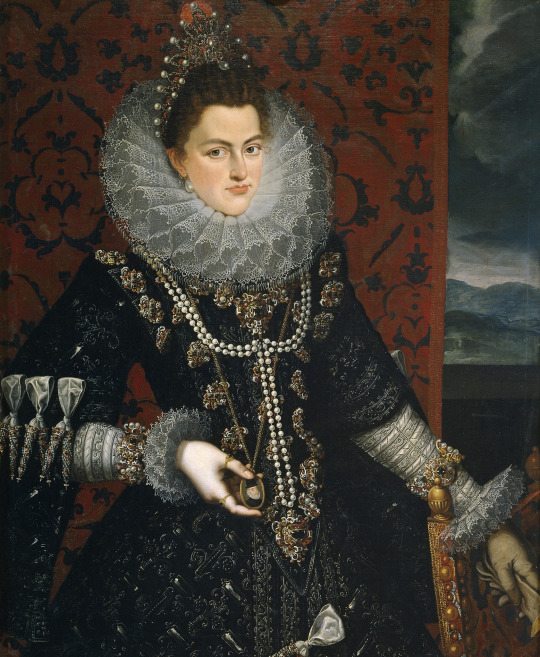
Juan Pantoja de la Cruz (Spanish, 1553-1608) Infanta Isabella Clara Eugenia of Spain- Spanish infanta, ruler of the Spanish provinces of the Netherlands, c.1598-99.
#Juan Pantoja de la Cruz#Pantoja de la Cruz#art#spanish art#classical art#traditional art#infanta#spanish infanta#Infanta Isabella Clara Eugenia#spain#netherlands#europe#european#europa#mediterranean#female#female portrait#princess#Spanish princess#noble#nobility#Aristocracy#aristocrat
100 notes
·
View notes
Text

Philip II of Spain, his four wives, and their children who survived to adulthood:
L-R:
Maria Manuela of Portugal with her son Carlos, who she died shortly after giving birth to.
Mary I of England, who experienced a false pregnancy but had no children.
Philip II
Elisabeth of Valois, with her daughters Isabella Clara Eugenia and Catherine Michelle. She also miscarried twin girls, and her youngest daughter died soon after birth.
Anna of Austria with her son, the future Philip III. Three sons: Charles, Ferdinand, and Diego, as well as a daughter named Maria, died in childhood.
#maria manuela of portugal#mary i#philip ii#elisabeth of valois#isabella clara eugenia of spain#catherine michelle of spain#anna of austria#philip iii#long live the queue
22 notes
·
View notes
Text

Oil Painting, ca. 1598-1600, Spanish.
By Frans Pourbus the Younger.
Portraying the Infanta Isabella Clara Eugenia.
Royal Collection Trust.
#royal collection trust#infanta Isabella Clara Eugenia#1598#1590s#1590s painting#1590s Spain#Spanish#Spain#womenswear#dress#16th century#Frans pourbus the younger
26 notes
·
View notes
Text


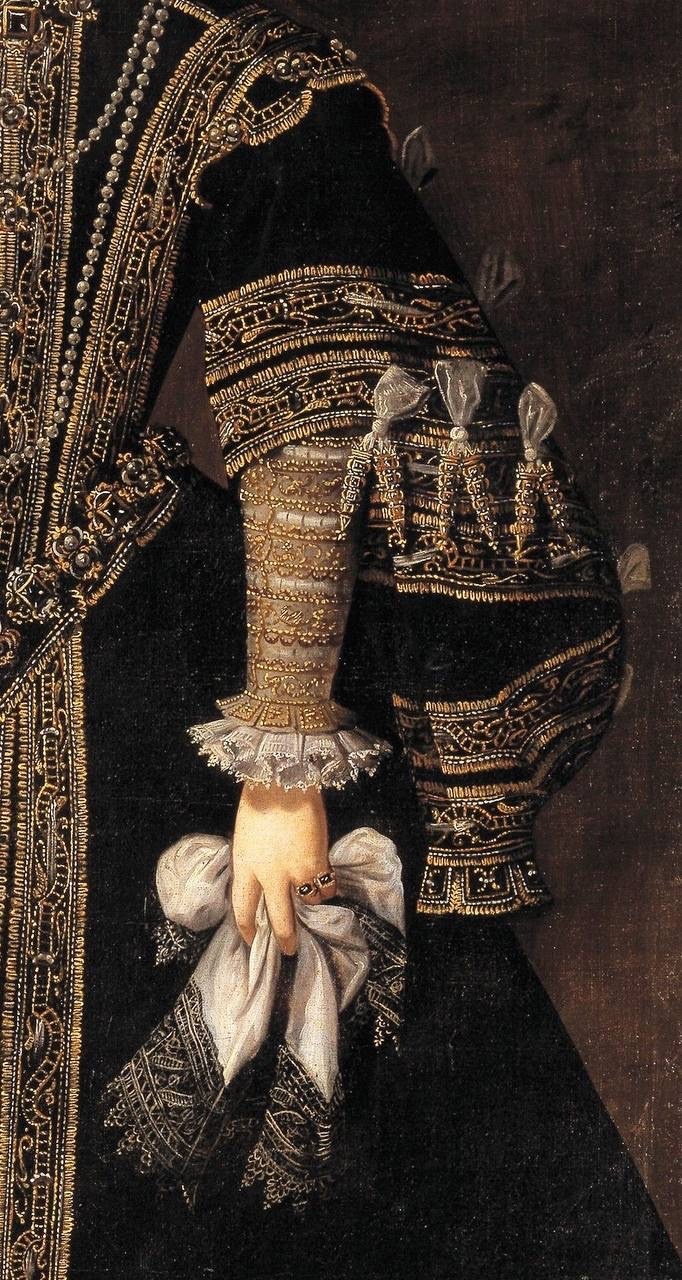
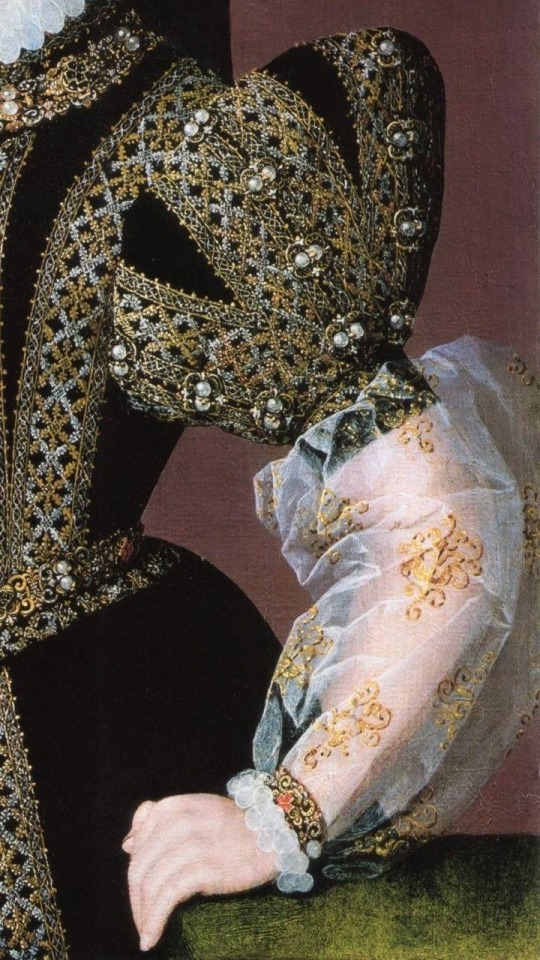
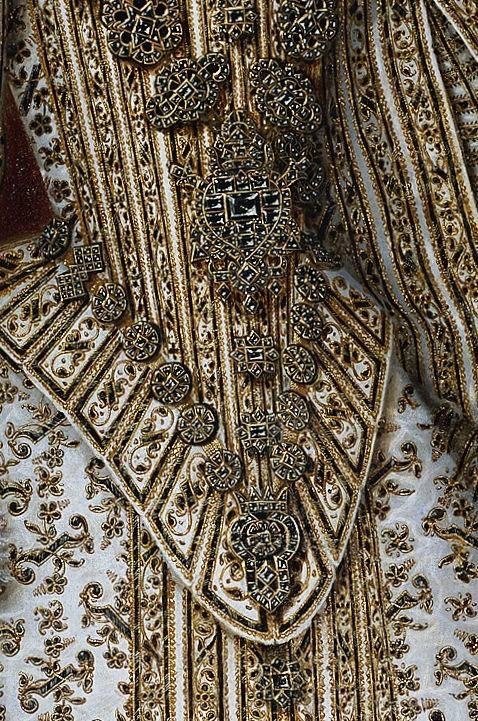


#margaret of austria#Elizabeth of France#Anna of Austria#Queen of Spain by Alonso Sanchez Coello#Isabelle- Elizabeth of France#Infanta Isabella Clara Eugenia of Spain#1600s art#drawing#Ana de Velasco y Giron by Juan Pantoja de la Cruz 1603#Juan Pantoja de la Cruz
10 notes
·
View notes
Text
Kensington Palace State Apartments Tour

The view from inside looking out.

(I don't remember what this is.)

The ceiling. We certainly don't see craftsmanship like this anymore!

More ceiling details.

A long gallery, with costumes showing court dress back during William and Mary's reign (1689 - 1702).

A close-up of the dress. Women had to walk through doors sideways! Dresses like this are also why rooms are so wide; they're large enough for women to pass by each other.

Queen's State Apartments - You are about to enter the oldest part of the palace. Step inside the intimate rooms created for Queen Mary II, who rules together with her husband, King William III, in the 17th century.
Virginian fun fact here: The College of William and Mary, located in Williamsburg VA, was created by royal charter in 1693 from King William and Queen Mary. It is the second-oldest university in the U.S. (Harvard is first, having been created in 1636) and one of the eight Public Ivies.

A bedroom

A sitting room

A writing desk in Queen Mary's drawing room

L: A family tree showing the House of Stuart. The yellow leaf represents Queen Anne. The red leaf at the bottom of the tapestry represents William IV (though I do remember someone on the tour group asking the guide if that was 'our William today'. That poor tour guide. I do commiserate with her - I worked a summer once at Jamestown and you would not believe how many people asked for directions to the Grandmother Willow Tree.)

Portrait of Isabella Clara Eugenia of Austria with her Dwarf, 1559

Another gallery

King William's throne

A staircase - exiting the State Apartments, going down to the Victoria exhibit.
This room really was as dark as it looks. You could just feel the history in this space, and there was so much to look at that.

The ceiling in the staircase

Another example of court dress. This one also shows the male uniform.

The courtier's uniform from the late 1700s

Another court dress

Some court brooches. I don't remember who these were - I think they're the family of one of the Georges.

One last ornate ceiling.
30 notes
·
View notes
Text
Master Post - N to Z
If you notice any show, movie or character missing that I’ve made gifs of, please let me know. Characters are sorted alphabetically by first their last name and then their first name.
Go to A-M | Last updated: December 19th, 2024
N
Nussknacker und Mausekönig (Louise Stahlbaum | Marie Stahlbaum | Zuckerfee/Sugar Fairy)
O
Oktoberfest 1900/Oktoberfest: Beer & Blood (Clara Prank | Curt Prank)
Once Upon A Time (Belle French | Colette French | Cora Mills | Ella Mills | Regina Mills / The Evil Queen | Robin Mills | Emma Swan | Anastasia Tremaine | Drizella Tremaine)
Once Upon A Time in Wonderland (Alice | Cora Mills | Anastasia Tremaine)
Outlander (Abigail | Marie Louise de La Tour d'Auvergne | Jocasta Cameron | Margaret Campbell | Geilis Duncan | Geneva Dunsany | Isobel Dunsany | Madame Elise | Brianna Fraser | Claire Fraser | Jamie Fraser | Janet “Jenny” Fraser Murray | Harold “Hal” Grey | John Grey | Lady Grozier | Mary Hawkins | Jeanne LeGrand | Louis XV | Mairi | Laoghaire MacKenzie | Letitia MacKenzie | Joan MacKimmie | Marsali MacKimmie | Mary MacNab | Elias Pound | Alexander Randall | William Ransom | Charles Edward Stuart | Suzette | Margaret Wake Tryon | Martha Washington | Elizabeth “Lizzie” Wemyss | Extras)
Oz the Great and Powerful (Evanora | Glinda | Theodora)
P
Q
Queen Charlotte: A Bridgerton Story (Agatha Danbury | Queen Charlotte | Violet Ledger | Wolfgang Amadeus Mozart | Princess Charlotte of Wales)
R
Reign (Aylee | Kenna de Poitiers | Amy Dudley | Robert Dudley | Claude of France | Greer Norwood | Penelope | Mary Stuart, Queen of Scots | Elizabeth Tudor/Elizabeth I | Elisabeth of Valois)
Reinas/Queens: The Virgin and the Martyr (Joanna of Austria | Empress Maria / Maria of Austria | Margaret Douglas | Bess of Hardwick | Isabel de Osorio | Mary Stuart, Queen of Scots | Isabella Clara Eugenia of Spain | Anna Throndsen | Elizabeth I/Elizabeth Tudor | Elisabeth of Valois)
Rise of Empires: Ottoman (Katarina Branković | Mara Branković | Gülbahar Hatun | Hüma Hatun | Constantine XI Palaiologos)
Romeo & Juliet [2013] (Juliet Capulet)
S
Sechs auf einen Streich (see the individual movies)
Shadow and Bone (Tatiana Lantsov | Zoya Nazyalensky | Genya Safin | Alina Starkov)
Sisi [2009] (Elisabeth “Sisi” of Austria | Archduchess Sophie of Austria | Helene “Néné” in Bavaria | Charlotte of Belgium | Eugénie de Montijo)
Sisi [2021] (Elisabeth “Sisi” of Austria | Archduchess Sophie of Austria | Helene “Néné” in Bavaria | Karl Ludwig von Grünne | Eugénie de Montijo)
Sissi Trilogy (Elisabeth “Sisi” of Austria | Archduchess Sophie of Austria | Helene “Néné” in Bavaria | Ludovika, The Duchess in Bavaria)
Snow White and the Huntsman (Ravenna)
Sophie - Braut wider Willen (Sophie von Ahlen)
Still Star-Crossed (Guiliana Capulet | Juliet Capulet | Rosaline Capulet | Tessa Montague | Princess Isabella of Verona)
T
The 100 (Emori | Clarke Griffin | Lexa)
The Age of Adaline (Adaline Bowman)
The Last Duel (Marguerite de Carrouges | Jacques Le Gris)
The Little Mermaid [2023] (Vanessa)
The Crown (Catherine Middleton | Queen Elizabeth II | Princess Margaret)
The Empress (see Die Kaiserin)
The Eras Tour (Taylor Swift)
The Gilded Age (Mamie Fish | Bertha Russell | Peggy Scott | Extras)
The Great (Countess Belanova | Catherine the Great | Georgina Dymova | Marial | Queen Agnes of Sweden | Extras)
The Greatest Showman (Jenny Lind)
The Hunger Games Trilogy (Katniss Everdeen | Peeta Mellark | Johanna Mason | Finnick Odair | Coriolanus Snow)
The Hunger Games: A Ballad of Songbirds and Snakes (Lucy Gray Baird | Livia Cardew | Arachne Crane | Clemensia Dovecote | Palmyra Monty | Iphigenia Moss | Juno Phipps | Persephone Price | Diana Ring | Vipsania Sickle | Tigris Snow | Lysistrata Vickers)
The Huntsman: Winter’s War (Freya | Ravenna)
The Originals (Davina Claire | Hayley Marshall | Aurora de Martel | Freya Mikaelson | Hope Mikaelson | Keelin Mikaelson | Rebekah Mikaelson)
The Other Boleyn Girl 2008 (Anne Boleyn | Elizabeth Boleyn (née Howard) | Mary Boleyn)
The Pillars of the Earth (Empress Matilda)
The Princess Switch (Margaret Delacourt | Fiona Pembroke)
The Royals (Princess Eleanor Henstridge | Queen Helena Henstridge | Wilhelmina “Willow” Moreno)
The Scandalous Lady W (Seymour Fleming)
The School for Good and Evil (Emma Anemone | Clarissa Dovey | Leonora Lesso)
The Serpent Queen (Catherine de Medici | Diane de Poitiers | Mary Stuart, Queen of Scots)
The Spanish Princess (Catherine of Aragon | Henry VIII | Mary Tudor)
The Tudors (Catherine of Aragon | Bessie Blount | Anne Boleyn | Anne of Cleves | Katheryn Howard | Ursula Misseldon | Kathryn Parr | Jane Seymour | Elizabeth Tudor/Elizabeth I | Margaret Tudor | Mary Tudor/Mary I)
The Twilight Saga (Charlotte | Alice Cullen | Edward Cullen | Katrina “Kate” Denali | Jasper Hale | Rosalie Hale | Peter | Bella Swan | Caius Volturi | Demetri Volturi | Jane Volturi)
The Vampire Diaries (Bonnie Benett | Caroline Forbes | Elena Gilbert | Jo Laughlin | Rebekah Mikaelson | Katherine Pierce | Annabelle “Anna” Zhu | Pearl Zhu)
The White Queen (Anne Neville | Isabel Neville | Margaret Plantagenet | Bona of Savoy | Elizabeth “Jane” Shore | Elizabeth Woodville | Cecily of York | Elizabeth of York | Margaret of York)
The White Princess (Mary of Burgundy | Elizabeth of York)
The Witcher (Calanthe of Cintra | Pavetta of Cintra | Tissaia de Vries | Philippa Eilhart | Sabrina Glevissig | Margarita Laux-Antille | Triss Merigold | Keira Metz | Lydia van Bredevoort | Yennefer of Vengerberg)
The Young Victoria (Victoria, The Duchess of Kent (née of Saxe-Coburg-Saalfeld) | Prince Albert of Saxe-Coburg and Gotha | Adelaide of Saxe-Meiningen | Queen Victoria)
Three Thousand Years of Longing (Hürrem Sultan | Kösem Sultan)
Trenck - Zwei Herzen gegen die Krone (Anna Amalia of Prussia)
Tulip Fever (Mrs Overalt | Sophia Sandvoort | Mrs Steen)
Tut (Ankhesenamun)
U
V
Vampire Academy [2022] (Vasilisa “Lissa” Dragomir)
Victoria (Queen Victoria | Victoria, Princess Royal)
Vom Reich zur Republik (Victoria, Princess Royal)
W
War & Peace [2016] (Natasha Rostova)
What We Do In The Shadows (Marwa | Nadja of Antipaxos)
Wolf Hall (Anne Boleyn | Catherine of Aragon)
X
Y
Z
13 notes
·
View notes
Text
Sofonisba Anguissola🧑🏻🎨
1532 -1625. Italy/Spain (above is a self portrait)
Sofonisba Anguissola was an Italian Renaissance Mannerist Painter born in Cremona, Northern Italy. Her family was a poor noble family of Greek decent who supported their children’s talents. Sofonisba had 5 sisters, Elena, Lucia, Europa, Anna Maria, and Minerva, and 1 brother, Asdrubale. 4 of her sisters became artists like her, Elena, who became a nun and stopped painting, Anna Marie and Europe gave up art after marriage, and Lucia died young. Minerva became a writer and Latin scholar, her brother studied music and Latin.
When Sofonisba was 14 she apprenticed with Bernardino Campi before he left. After that she studied with Bernardino Gatti aka IlSojaro. At 22 Sofonisba went to Rome were she was mentored by Michelangelo (of Sistine Chapel fame). At 26 she was scouted by king Philip II of Spain to become court painter, lady in waiting and tutor to his 3rd wife, Elizabeth of Valois and her daughters Isabella Clara Eugenia and Catalina Micaela who were amateur artists. Sofonisba spent 14 years in residence in Madrid, Spain.
At almost 40ish Phillip decided that Sofonisba should get married. He provided her with a dowry and arranged a marriage with Fabrizio Mocada Pignatelli, son of the Viceroy of Sicily. He didn���t mind her painting and they were married until his death I 1579 of mysterious causes. During those times Sofonisba supported her remaining family and King Phillip gave her a pension of 100 ducats (maybe $15,000 US today)
After her husband’s death Sofonisba fell in love with a shops captain and sea merchant Orazio Lomellino. In 1620 they were married against her brother’s wishes. She had no kids with either of her husbands. As she got older she began to lose her vision and used her money to help other artists. She died in 1625 at 93 in Palermo.
There is a crater in Mercury names Anguissola after her.
(Below is elderly Sofonisba from 1619 on the right is Sofonisba c.1560 both are self portraits)


Source for info and images is Wikipedia
3 notes
·
View notes
Text
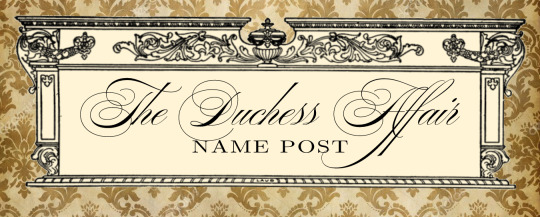
Hello one and all and welcome to the The Duchess Affair name post. This is a list of period-accurate given names you can give your MC if you need some inspiration or want to know what kinds of names ladies had back then. I've combed through the 1809 edition of Debrett's Peerage for names of noblewomen in the 1600s and 1700s in Britain, which is where I'm taking the liberty of assuming TDA is set.
As always, you can drop any questions in my inbox, I love love love playing reference librarian :-)
Most names in this period either came from the Bible or from literature. The Bible was the most common book owned and read, so Biblical names were frequently seen. Some nobles liked to show off how cultured and educated they were by naming their children after mythological figures or characters from poetry and history, but most people of all classes named children after ancestors or loved ones (which explains why it seems like it was the same dozen names getting passed around again and again.)
Very common names -- the majority of women back then had one of these names:
Anne
Caroline
Catharine (not a typo – this was the standard spelling in the 1700s!)
Charlotte
Diana
Elizabeth
Frances
Georgiana
Henrietta
Isabella
Jane
Louisa
Margaret
Maria (pronounced like “Mariah”)
Martha
Mary
Sarah
Sophia
Less common but not unheard-of names:
Agnes
Alathea
Albinia/Albina
Alicia/Alice
Amelia/ Emilia/Emily
Arabella
Augusta
Barbara
Bridget
Cassandra
Cecilia/Cecily
Clarissa
Constance/Constantia
Dorothea/Dorothy
Eleanor
Emma
Gertrude
Grace
Harriet/Harriott
Hester
Honora/Honoria
Jemima
Judith
Julia
Juliana
Lavinia
Laetitia/Letitia
Laura
Lucy
Marianna/Marianne
Matilda
Penelope
Priscilla
Rachael
Rebecca
Susan/Susanna/Susannah
Theodosia
Theresa
Thomasina/Thomasine
Rarities and oddities -- I only came across these names once or twice each, use them to add a bit of flavor and eccentricity!!!:
Abigail
Amabel/Amabella
Amantha
Anastasia
Angelica
Annabella
Antonia
Araminta
Beatrix
Camilla
Christiana/Christina
Clara
Clementia/Clementina
Dulcibella
Esme
Ethelred
Eugenia
Felicia
Flavia
Flora
Florentia
Frederica
Gabriella
Helen/Helena
Horatia
Josepha
Leonora
Madelina
Margaretta
Narcissa
Octavia
Olivia
Philadelphia
Rose
Selina
Sibella/Sibilla/Sibylla
Tryphena
Urania
Winifred
And just for fun, some extremely British sounding surnames I found that made me chuckle aristocratically:
Beckington
Cavendish
Chatham
Courtenay
Dalrymple
Darlington
Fortescue
Gainsborough
Kingscote
Lovelace
Mountstuart
Ogilvie
Pembroke
Pierrepont
Posonby
Tattershall
Twisleton
Wentworth
Willoughby
Wriothesley
#playchoices#the duchess affair#choices the duchess affair#the duchess affair choices#choices tda#tda choices#duchess affair
39 notes
·
View notes
Text
Portrait of the Archduke Albert and the Infanta Isabella
Artist: Studio of Peter Paul Rubens (Flemish, 1577-1640)
Date: c. 1615
Medium: Oil on canvas
Collection: The National Gallery, London, United Kingdom


The Archduke Albert and the Infanta Isabella
Description
The two portraits were made as pendants, or companion pieces, and would have hung side by side. The two figures are turned towards each other in the accepted tradition of pictures of betrothed or married couples, and they look out at us, as if we are witnesses of their union. They are the Archduke Albert of Austria and the Infanta (or Princess) Isabella, joint sovereigns of the Seventeen Provinces of the Spanish Netherlands. Sovereignty was granted to them by Isabella’s father, Philip II of Spain, on their marriage in 1599.
This was a tempestuous time in the history of the Netherlands, which had been ruled by Spain for generations. The Southern Provinces (Flanders) were, like Spain, Roman Catholic, but the Northern Provinces were predominantly Protestant and had fought hard for independence. Albert and Isabella were, in effect, rulers of Flanders only. While their predecessors had determined to Hispanicise Flanders with violent episodes of bitter warfare, Albert and Isabella had a strong sense of duty to the people as well as to the Spanish crown. They set out to create a sense of national identity – Roman Catholic, but with an independent character within the Spanish Imperial domains. They were the most benevolent of the long line of Habsburg incumbents and there was a lull in the worst of the violence. The prosperity this brought was recognised by the population, including Rubens, whose order book for portraits became quickly filled.
The couple were both patrons of the arts, and they influenced taste in painting and sculpture in particular. Albert created Rubens paintre de l’hostel, or court painter, along with two others, Jan Brueghel the Elder and Otto van Veen. They and the court architect, Wenzel Coebergher, became part of Albert and Isabella’s close circle. Albert was particularly fond of Rubens, who named his firstborn son after the Archduke. After Albert’s death in 1621, Isabella became sole sovereign. As a highly educated man, diplomat and devout Catholic, Rubens remained her trusted adviser in the struggle to maintain peace between the divided provinces. Isabella died in 1633, and the brief period of peace died with her.
The paintings are unlikely to be by Rubens’s own hand, but are studio copies. They were possibly made after two originals which are now lost but which are known through prints made after them. Two other portraits of Albert and Isabella that are definitely by Rubens were in his studio after his death and are now in the Kunsthistorisches Museum, Vienna.
#portrait#painting#male#female#archduke albert#infanta isabella#netherlands#costume#house of hasburg#european#peter paul rubens#flemish painter#albert vii of austria#spanish netherlands#isabella clara eugenia#european art#artwork
10 notes
·
View notes
Text
Infantas Isabella Clara Eugenia and Catalina Micaela with their pets, painted by Sofonisba Anguissola (1535-1625)

#ora parlo io 🥶#women artists#Women painters#Art#Women's art#Sofonisba Anguissola#painting#renaissance#renaissance painting
4 notes
·
View notes
Text

Juan Pantoja de la Cruz (Spanish, 1553-1608) Portrait of the Archduchess Infanta Isabella Clara Eugenia, ca.1600 Meadows Museum, Southern Methodist University
#Juan Pantoja de la Cruz#netherlandish#spanish netherlands#art#spanish princess#infanta#infanta isabella clara eugenia#1600s#fine art#1500s#classical art#european art#europe#european#oil painting#fine arts#mediterranean#europa#spanish#hispanic#latin#spanish art#spanish artist#archduchess#royal#noble#nobility#aristocrat#aristocracy#southern europe
32 notes
·
View notes
Photo

Isabella Clara Eugenia of Spain, Governor of the Habsburg Netherlands.
#Isabella Clara Eugenia of spain#house of habsburg#habsburg#16th century#16th century art#long live the queue
49 notes
·
View notes
Text


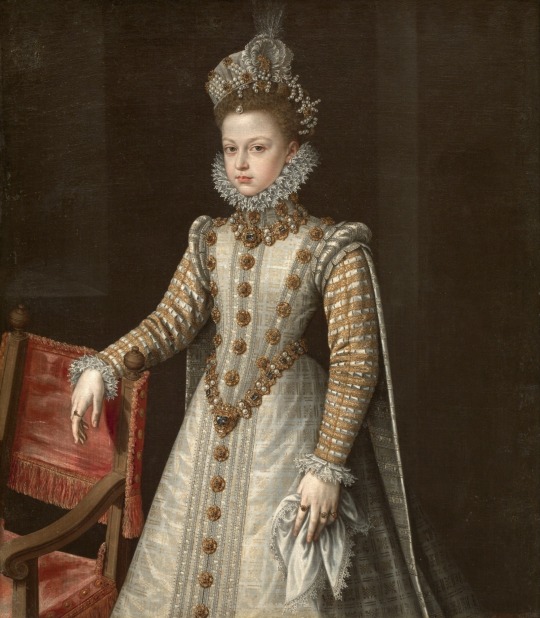
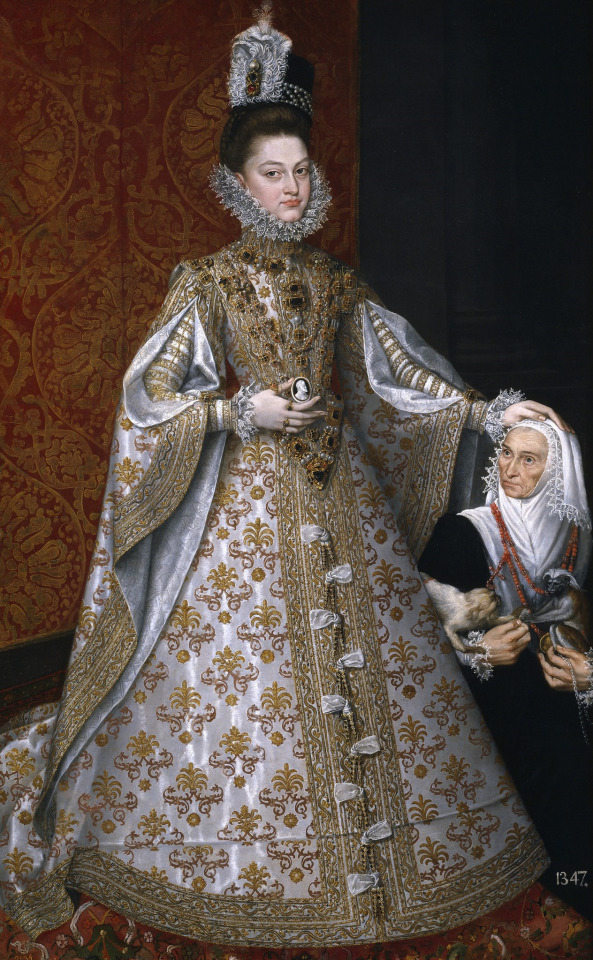




The Infanta Isabella Clara Eugenia (Spanish, 1566-1633): Sovereign of the Netherlands, Duchess of Lothier, Brabant, Limburg, Luxemburg, and Guelders, Margravine of Namur, Countess Palatine of Burgundy, Countess of Flanders, Artois and Hainaut. [source]
1. Attributed to Alonso Sánchez Coello (1531-1588) and Workshop, Isabella Clara Eugenia and Catharina, Daughters of Philip II, King of Spain, c. 1569-70, oil on canvas; The Royal Collection Trust, Green Drawing Room, Buckingham Palace.
2. Alonso Sánchez Coello (Spanish,1531-1588), The Infantas Isabel Clara Eugenia and Catalina Micaela, circa 1575, oil on canvas, Museo del Prado, Madrid.
3. Alonso Sánchez Coello (Spanish, 1531-1588), Infanta Isabella Clara Eugenia, 1577, oil on canvas, Museo del Prado, Madrid.
4. Alonso Sánchez Coello, The Infanta Isabella Clara Eugenia and Magdalena Ruiz, 1586, oil on canvas, Museo Nacional del Prado, Madrid.
5. Juan Pantoja de la Cruz (Spanish, 1553-1608), The Infanta Isabel Clara Eugenia, 1598-99, oil on canvas, Museo del Prado, Madrid.
6. Frans Pourbus the Younger (Flemish, 1569-1622), The Infanta Isabella Clara Eugenia, Archduchess of Austria, c. 1598-1600, oil on canvas.
7. Peter Paul Rubens and Workshop (Flemish, 1577-1640), Portrait of Archduchess Isabella Clara Eugenia, Spanish Regent of the Low Countries, as a Nun, 1625, oil on canvas.
8. Anthony van Dyck (Flemish, 1599-1641), The Infanta Isabella Clara Eugenia, c. 1630, oil on canvas, Walker Art Gallery.
Infanta Isabella Clara Eugenia (Spanish, Segovia, 1566 - 1633, Brussels) was the daughter of Philip II of Spain and his third wife, Elizabeth of Valois, who died after a miscarriage when the Infanta was only two. Her sister Catalina Micaela was one year younger.
She became the sovereign of the Spanish Netherlands in the Low Countries and the north of modern France with her husband, Archduke Albert VII of Austria. She was one of the most powerful women in Europe at the time. The couple had no children. She joined the Sisters of St. Clare order after her co-regent's death.
#infanta isabel clara eugenia#spanish royalty#powerful women#alonso sánchez coello#juan pantoja de la cruz#frans pourbus the younger#peter paul rubens#anthony van dyck#16th century#17th century#european history
40 notes
·
View notes
Text
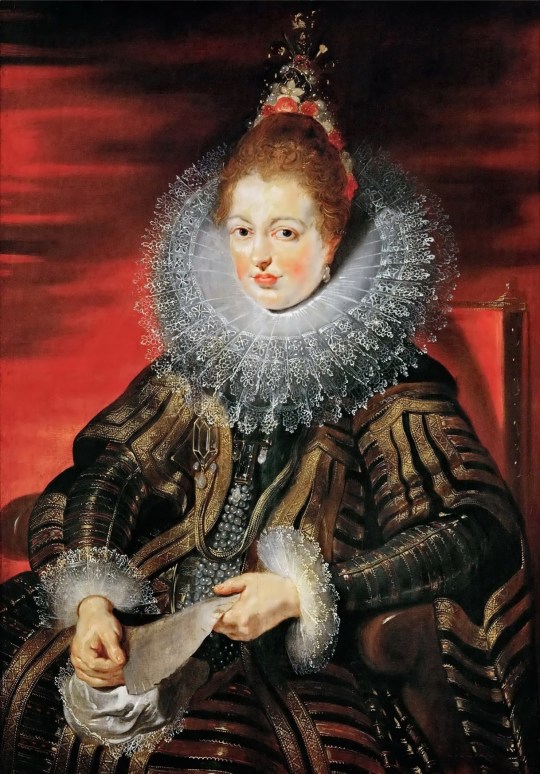
Peter Paul Rubens • Infanta Isabella Clara Eugenia, Wife of Archduke Albrecht VII • c. 1613/15
The Resplendent Outfit: The outrageous, extravagant, sometimes humorous and often beautiful outfits worn by subjects of old portraits; sometimes captioned, as an attempt at satire; a little history occasionally thrown in the mix.
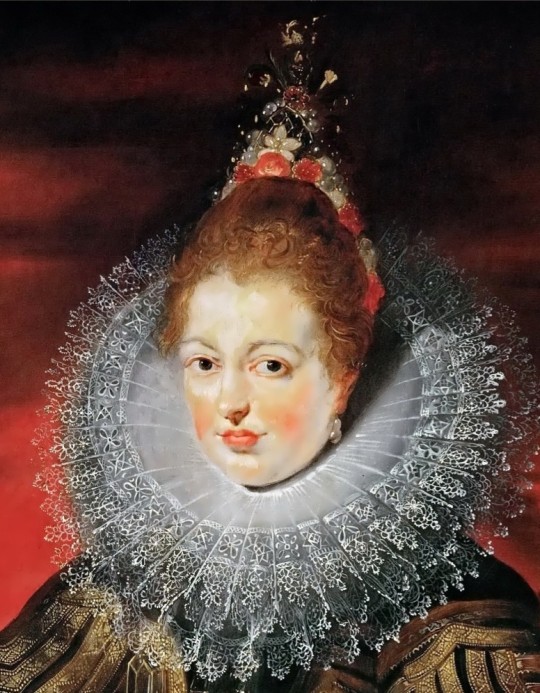
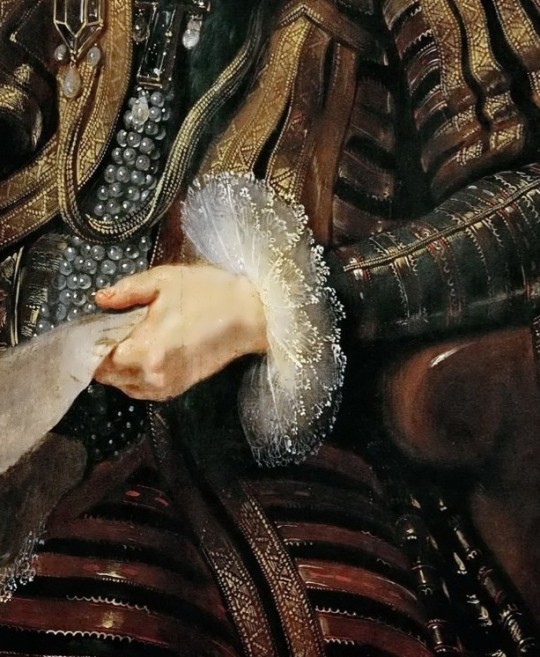
Details
A Brief History of the Ruff
In the 16th century ruffs became popular for both men and women. It was a separate accessory whose function was to protect the overall garment from becoming soiled at the neck. It could be removed and laundered separately. The ruff evolved from the medieval split collar which likely served the same function.
The ruff collar started as a simple circle and throughout the century evolved into rather large, stiff contraptions (such as the one worn in the portrait above) that restricted movement. Because of this, it was thought to force its wearer to conform to proper posture. Its size and impracticality were somehow symbolic of the wealth of its owner.
The popularity of the ruff extended well into the 17th century.
Fun Fact! These collars are sometimes referred to as Medici collars as they were popularized by Maria de’ Medici, Queen of France.
#portrait#art#painting#royal portraits#baroque art#peter paul rubens#dutch artist#history of the ruff#fashion history#16th century fashion trend#fine art#the resplendent outfit#maria de' medici
6 notes
·
View notes